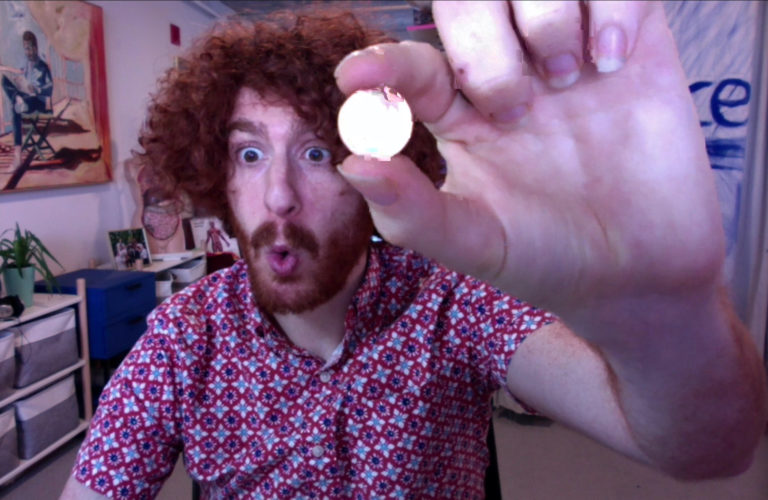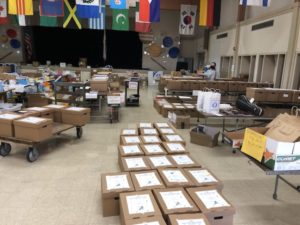
Four years ago, when Stuart Loebl taught biology at Kennedy High School in Richmond, California, he noticed a disconcerting trend. A third of his students were reading at a fifth-grade level or below, and many had never taken a real science class before. It marked a turning point in Loebl’s career: he decided to work with younger students to ensure that they could reach high school science classes with the skills necessary to succeed. Now, as a teacher at Lorin Eden Elementary School in the Hayward Unified School District, Loebl with the guidance of teacher Nancy Wright have started a Science Kit program to encourage hands-on, inquiry-based investigations. The kits are one example of how the Hayward Unified School District is striving to provide deeper learning experiences that are engaging, equitable, and provide students the tools that they need to think critically, consistent with their Strategic Plan for the next three years. With distance learning during the 2020-2021 academic year, the kits have provided much needed materials to cultivate learning at home. Loebl and Wright spoke with ESAL about how the kits were developed and the impact they were having on students.
CK: What is your current role as an educator?
Loebl: I've been teaching at Lorin Eden Elementary School for the past two years. I teach about 327 adorable little kids in first through sixth grade. I teach some of the most fundamental levels of science. We do plantings to learn about photosynthesis. We learn about magnets and forces and earth structures. It's great! But mostly what I work on with them is getting them to think like a scientist in terms of using their observational skills and figuring out to test ideas.
CK: How did you develop the idea for Science Kits?

Science Kits being packaged for students.
Loebl: A lot of school districts are talking about how they're trying to prioritize STEM, but I don't see that happening for the younger students. There's still such a focus on English and math, which is important, but it's also not all that we should be teaching these kids at these young ages. This is especially true given that science is an opportunity to apply math and the language arts. So these Science Kits are going to be an opportunity to engage the teachers who are not doing a lot of science teaching and get them to start thinking about how to put that into their curriculum.
Wright: Every student in Hayward deserves a science education that prepares them for a future in STEM. Distance learning does not change this. We needed to ensure that students got the science education that they deserve, one in which allows them to engage in science and engineering practices with hands-on materials. These kits allow students to develop critical thinking and problem solving skills, as well as organizational skills as they deepen their science understanding. Students will understand that science doesn’t just happen in a science lab, but that science is all around us. Students are empowered to do science at home with these kits. This is the first step in getting students to see themselves as scientists.
CK: What are Science Kits?
Loebl: We have some of what maybe might be considered the most basic things for engineering and crafting, such as tape, string, and rubber bands, which are great for learning about sounds and vibrations. We have these items in the kits because although you might assume most kids have these materials at home already, many just don’t. We have pipettes in the kits too because we want students to be comfortable transferring liquids from one space to another. The kits are also for learning how to use the tools of science.
Thinking back again to my Kennedy days, a lot of my students just didn't have the basic understanding of how to measure something. If you ask a student to pour out 20 milliliters of liquid, it would take them a very long time to be able to figure that out because they hadn't really done that before. So we're giving them cups that have measuring lines on them so they can practice that skill. When they get to high school chemistry, they will know how to do that and they can pass that class. In my pilot kit, that I gave out to my students at Lorin Eden, there were over a hundred materials. The kits for the whole Hayward district have been reduced to the absolute most essential objects, because as we scaled up, we needed to make sure every material was easy to assemble and cheap. The kits are all under $5 and there are 34 materials in there.
CK: Can you go in specifics about at least one project?
Loebl: One of my favorite experiments is having the students think through conductivity. We have given students things to make ice in the kits because about a third of my students don't have either ice makers or ice cube trays in their freezers. We ask them to make two ice cubes that are of the same size and have them touch something that's metal and something that is wood or foam. We have them guess which material is going to melt the ice faster. Inevitably, students think that the ice is going to melt faster on the foam or the wood, because that feels warmer than the metal, but of course it’s the opposite.
Another project I enjoy teaching is one about material science in which we use ping pong balls and golf balls. The two balls are of similar volume, but obviously have very different densities. Just on such a basic level, we want the student to push them around and realize that you need a little bit more force for the golf ball and the ping pong ball. And then we’ll move to more interesting experiments about gravity and Galileo where we drop both the balls at the same times and see which will hit the ground first.
CK: How many students use the kits and what are the major goals of the kits?
Loebl: There are roughly 12,000 elementary students in Hayward Unified School District. Currently 4,000 students will be getting these kits, so we are covering about one third of elementary students. I'm hoping to increase that number to 8,000. One of the major goals of the kits is to cultivate students as investigators and as scientists. I feel very strongly that the way to learn these skills is through hands-on experiential approaches. The lessons that I remember from when I was a kid are those kinds of lessons. For example, I remember sitting down in second grade and being given a whole bunch of magnets. I was playing around with them and figuring out polarities. In my opinion, science is not best taught as a lecture. It needs to be something that you can try out yourself. That insight was really, really important to me as we went into distance learning. I was trying to figure out how to retain this essential element of what teaching science is all about when kids just don't have the materials we would typically be able to provide to them in school.
The district has provided $30,000 for the kits. About a third of the cost of the kits is for professional development for teachers. We spent a lot of time considering how we don't want the kits to be sent out and then for families to get these materials and not really know what to do with them. We spent time developing with teachers how to utilize these kits in their curriculum. Elementary teachers routinely ask for science curriculum materials and professional development. This program will provide all three of those, as we are going to be supporting every teacher who receives the kit with paid professional development and an open source digital library of lessons.
Wright: Distance learning has been challenging for a variety of reasons, but that doesn’t mean that students shouldn’t be building a strong science foundation in elementary school. Science enhances critical thinking, cultivates a passion for learning, and promotes reading, writing, and math skills. Ideally, students would have access to meaningful, hands-on science investigations, but that is difficult to ensure when students are at home. These kits allow students to have the materials that they need to engage in science safely at home. Teachers will also get the resources they need to support their students' science learning, including professional development, lessons, and collaboration. One major goal of this project is to support teachers and students as they transition their science teaching and learning to alignment with the Next Generation Science Standards, which promotes a new way of teaching and learning that allows students to actively do and experience science in a deep, meaningful way, not just learn about it from a textbook or a lecture. My vision for this project is to cultivate a passion for science education among teachers and students that will endure long past the time we return to in-person learning.
CK: What kind of feedback have you received from your students about the kits?
Loebl: They love it. They're constantly thinking through different ways that they can learn. I've been getting videos from students about them doing this and that kind of experiment. In my original kits, we gave them food dye and there was a student who sent me a video of them mixing the water with food dye and oil with their parents. They saw clearly how those two different liquids don't mix.
I think that parents really, really appreciate the kits because I’m not just throwing materials at my students but providing activities and lessons and ways to think through concepts. And I think parents appreciate during lockdown that they can still be guided through ways of thinking through science. They can do activities with their kids and stay engaged.
Are you involved with an organization or effort that you think might be of interest to the ESAL community? Or have heard about an organization or initiative that you’d like to learn more about? Let us know here, and we may feature it in a future post.